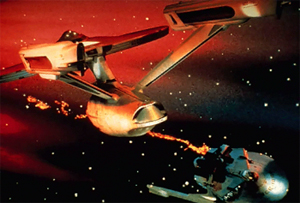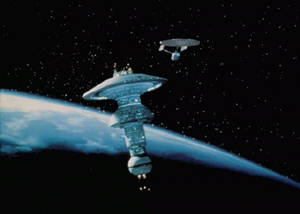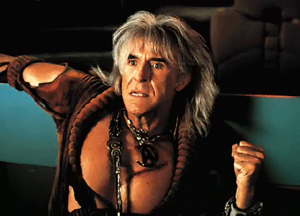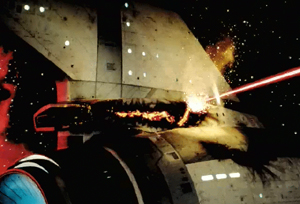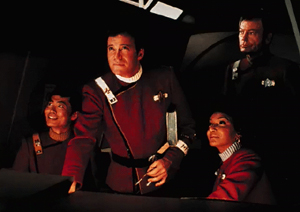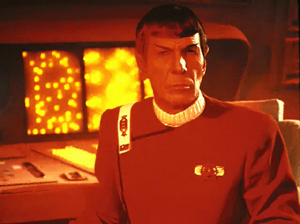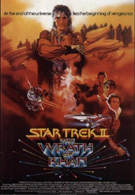In my time writing for all of you at The Film Hobbit, you’ve probably heard me rant on and on about how much I love Star Trek (at least the even numbered ones) more than you’d care to. So I figured it was about time I sat down and talked a bit about the one piece of Star Trek history that means the most to me… and to the franchise, Star Trek II: The Wrath of Khan.
I grew up watching Star Trek, probably because Star Trek was just about the only thing my dad and I ever had in common. In the early 80’s I’d run home from kindergarten to watch the re-runs, sometimes hiding behind the couch when things go too scary. I don’t remember really noticing when the first two Star Trek movies came out. I was probably to young to watch prime time and see the ads. Besides, my parents weren’t about to let me see them. In those days they fed me a strict diet of rated “G” moviemaking, anything else was unthinkable. I do remember BEGGING to see Star Trek 3… and being staunchly denied.
So for me, the first time I ever saw Star Trek on an actual movie screen was pretty far into it’s run, with Star Trek IV. A weekend away from my puritanical Mom afforded my dad the opportunity for us to slip into a theater and enjoy. I’m not sure we ever told her. She was sorta nuts about those things, resulting in my insane lust for movies of all ratings and types as soon as I was 16 and old enough to finagle a rental card out of my local video store. Anyway, Star Trek IV: The Voyage Home was my first real introduction to Star Trek in film… but after that I was gung ho for a much larger world of Captain Kirk.
Fortunately for me, around that time some of the TV networks got it into their heads that it might be fun to run Star Trek movies on the weekends… sometimes it seemed like they did it every month. And that was my introduction to Star Trek II: The Wrath of Khan, a movie that has wowed, delighted, and captured me, even though I first saw it piped through a pair of worn-out rabbit ears on a 12’ inch, pliers activated, semi-color, circa 1977 TV set.
But somehow, the magic shined through. There he was, Captain Kirk (William Shatner), bold, brash, not quite so young yet not quite so old. Facing the battle of his life as he always did, head on. On what should have been a routine training mission, the Enterprise receives a distress call from space station Regula One, run by one Carole Marcus (Bibi Besch), scientist, leader, and yet another past conquest of now Admiral James T. Kirk. Enterprise rushes to investigate, only to encounter Reliant… a Federation battle cruiser boarded, subdued and controlled by the one man in the universe who hates Kirk most, Khan (Ricardo Montalban). A genetically engineered super-human from the past, Khan blames Kirk for the death his wife, and means to take his revenge on Kirk’s old flame, or even his newfound son.
In the tradition of the best submarine movies, what ensues is a battle of wits and cunning the likes of which would stir the blood of any man. In the deep dark coldness of space, both ships stalk one another, wounded but not destroyed. Both commanders are brilliant, but desperate. This fight has become personal, and Kirk has only his crew to depend on. In the end, their survival hinges on an ultimate sacrifice, which can only be made by the man Kirk needs most.
Shatner often gets a rep as a bad actor. But in the earlier Star Trek films, Star Trek’s 2 and 3 in particular, his performances are practically Oscar caliber. Maybe pitting him against the likes of Ricardo Montalban helped bring out that little something extra inside him. Ricardo himself is so completely brilliant as Khan that he sets himself on high as one of the most convincing and memorable movie villains of all time. Shouting lines with venom and intelligence, Khan Noonien Sing strides the cosmos with an almost inescapable charisma and wicked cunning unmatched by that of any other ne'er-do-well.
This isn’t the Shatner show though. Unlike some more recent Trek flicks, which seem to abandon most of the established crew in favor of focusing almost exclusively on the Captain as a primary character, Wrath of Khan smartly stops to give everyone their piece, fitting the entire crew in seamlessly and smoothly as part of one united whole, rather than some William Shatner vanity piece. Nimoy and Kelley in particular stand out, as the lynch pins in the film’s ending. It is here that Leonard delivers one of the most touching and heartfelt death scenes ever felt in American cinema. You will believe a grown man can cry. Such is the attention to detail, there’s even time to work in new crew. It’s here that Kirstie Alley actually first made her name as the half Romulan half Vulcan crewwoman Savvik. Her role becomes increasingly important in subsequent films and though she is only played once by Alley, it is she who defines the character and makes her a beloved part of an already established crew.
With an original score by James Horner and an impressive array of visual effects showcasing what sort of eye popping things can be done entirely with models, Wrath of Khan is a visual and aural feast. Phasers flash through the cosmos and torpedoes flare in what can only be described as the ultimate duel of wits and intelligence. Horner’s score is direly dramatic with just the right touch of lightness necessary for any humorous twitches involving pointed ears that might pop up here and there.
Star Trek has never been so alive as it is here in the capable hands of director Nicholas Meyer. Gene Roddenberry’s vision has never been so clear, so gripping, so much a gut wrenching, mind blowing, truly cinematic experience. Star Trek II: The Wrath of Khan is a movie that transcends it’s genre, it’s format, it’s fan base to really get inside the hearts and heads of people across all barriers the world over. This is the way to make Star Trek movies RIGHT and even today the folks at Paramount are still desperately searching to recapture it. At the center of the most successful Science Fiction franchise in history is the Enterprise and her noble crew. At the center of this movie fan’s film universe is one fantastic experience called Star Trek II.
